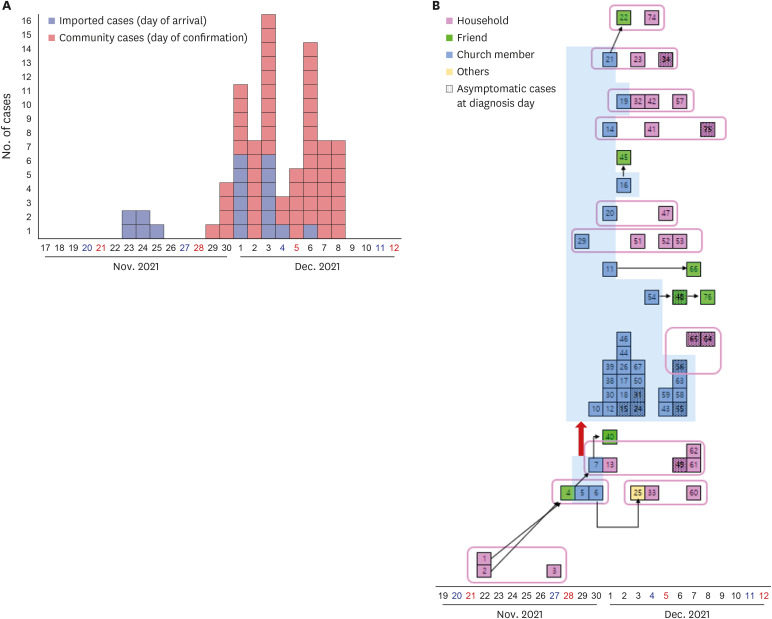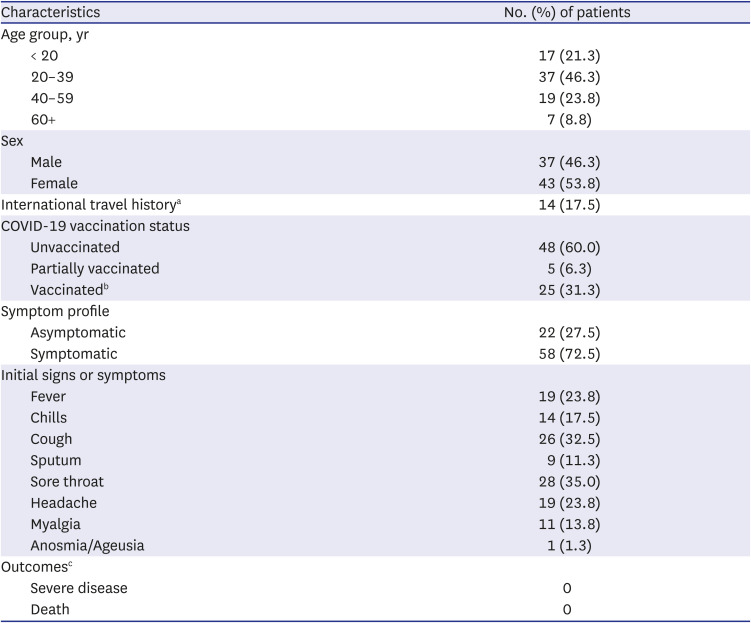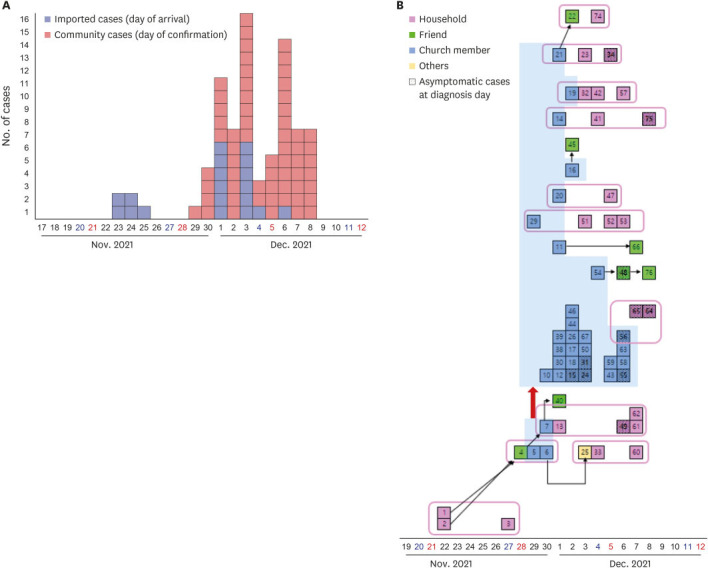This article has been
cited by other articles in ScienceCentral.
Abstract
In November 2021, 14 international travel-related severe acute respiratory syndrome coronavirus 2 (SARS-CoV-2) B.1.1.529 (omicron) variant of concern (VOC) patients were detected in South Korea. Epidemiologic investigation revealed community transmission of the omicron VOC. A total of 80 SARS-CoV-2 omicron VOC-positive patients were identified until December 10, 2021 and 66 of them reported no relation to the international travel. There may be more transmissions with this VOC in Korea than reported.
Go to :

Graphical Abstract
Go to :

Keywords: Coronavirus, COVID-19, SARS-CoV-2, Omicron Variant
Severe acute respiratory syndrome coronavirus 2 (SARS-CoV-2) B.1.1.529 omicron variant of concern (VOC) was first reported on November 24, 2021 in South Africa, and has quickly spread globally.
1 The first two patients infected with omicron VOC in South Korea was identified on November 25, 2021, during the screening of inbound international travelers at the airport. Herein, we describe the omicron VOC prevalence over time and epidemiological and clinical characteristics of the confirmed patients.
Details of the surveillance system have been described earlier.
2 Public health officers interviewed patients about demographics, vaccination history, and symptoms. In all cases and contacts, nasopharyngeal swab specimen was collected for reverse transcriptase polymerase chain reaction (RT-PCR) tests. Incubation period was calculated from time of exposure, and the serial interval was estimated based on the time from symptom onset in index cases to symptom onset in corresponding contacts.
During November 24 - December 10, 2021, a total of 80 SARS-CoV-2 omicron VOC-positive patients were identified in Korea (
Table 1). In total, 14 (17.5%) patients had history of international travels within 14 days of symptom onset, or if asymptomatic, SARS-CoV-2 test results (Nigeria, n = 10; South Africa, n = 2; Mozambique, n = 1; Ethiopia, n = 1, Iran, n = 1;
Fig. 1A). Among community transmission cases, 26 were from households, and 12 were from church-related clusters (
Fig. 1B). Among 78 patients with documented history of vaccination, 48 (60.0%) were unvaccinated, and 25 (31.3%) were vaccinated. The vaccinated persons have received BNT162b (n = 13), mRNA-1273 (n = 5), Ad26.COV2.S (n = 4), and ChAdOx1 (n = 3) vaccines (
Table 1).
 | Fig. 1Chronological distribution of SARS-CoV-2 B.1.1.529 (omicron) variant of concern cases. (A) Epidemic curve of reported confirmed cases (n = 80). (B) Patterns of community transmission.
|
Table 1
Characteristics of reported confirmed SARS-CoV-2 B.1.1.529 (omicron) variant of concern cases (n = 80), South Korea, November 24 - December 10, 2021

|
Characteristics |
No. (%) of patients |
|
Age group, yr |
|
|
< 20 |
17 (21.3) |
|
20–39 |
37 (46.3) |
|
40–59 |
19 (23.8) |
|
60+ |
7 (8.8) |
|
Sex |
|
|
Male |
37 (46.3) |
|
Female |
43 (53.8) |
|
International travel historya
|
14 (17.5) |
|
COVID-19 vaccination status |
|
|
Unvaccinated |
48 (60.0) |
|
Partially vaccinated |
5 (6.3) |
|
Vaccinatedb
|
25 (31.3) |
|
Symptom profile |
|
|
Asymptomatic |
22 (27.5) |
|
Symptomatic |
58 (72.5) |
|
Initial signs or symptoms |
|
|
Fever |
19 (23.8) |
|
Chills |
14 (17.5) |
|
Cough |
26 (32.5) |
|
Sputum |
9 (11.3) |
|
Sore throat |
28 (35.0) |
|
Headache |
19 (23.8) |
|
Myalgia |
11 (13.8) |
|
Anosmia/Ageusia |
1 (1.3) |
|
Outcomesc
|
|
|
Severe disease |
0 |
|
Death |
0 |

Most of the first 80 SARS-CoV-2 omicron VOC-positive patients were with mild symptoms, and 27.5% were asymptomatic, and no cases were with severe diseases nor death during 6.1 mean observed days (range, 2–16 days). Estimated incubation period was 4.2 days (range, 2–8 days) and serial interval was 2.8 days (range, 1–7 days).
We describe the first 80 patients of SARS-CoV-2 omicron VOC-positive patients identified in South Korea, which have rapidly transmitted to the community in the households and the church. Epidemiologic features of the omicron VOC have not been fully characterized in other places.
3 Our finding of short serial interval of 2.8 days is in line with findings from South Africa, with growing reproductive number compared to the delta VOC.
4 Meanwhile, none of the first 80 patients underwent severe disease or death as in the US, which was reassuring, yet, should be monitored further.
5 The hypothesis of trade-off between virulence and transmissibility has been proposed decades ago, which may be supportive to the evolution of SARS-CoV-2 in the long term.
6
Note that 60% of omicron VOC-positive patients were unvaccinated, which emphasizes the need for vaccination to limit the transmission. Yet, given the high rates of mutation that omicron VOC carries, vaccine effectiveness should be investigated further.
7 Earlier findings from South Africa suggest the efficacy of coronavirus disease 2019 vaccine may be significantly reduced against omicron VOC.
8
Because information about these early cases of SARS-CoV-2 omicron VOC are selected from import-related incidents, our interpretation should be made cautiously. Moreover, given the relatively short observation time, further follow-up is needed to ascertain the disease severity of this specific VOC as more data are reported globally.
In summary, importation of SARS-COV-2 omicron VOC has caused a substantial community transmission in Korea, especially among unvaccinated persons. Although the initial findings on clinical features are reassuring, continuous monitoring of the disease epidemiology and vaccine effectiveness should be in place.
Ethics statement
The present study used the quarantine data which were constructed as a legally mandated public health investigation under the authority of the Korean Infectious Diseases Control and Prevention Act (No. 12444 and No. 13392). The study protocol was reviewed and approved by Institutional Review Board of the Korea Disease Control and Prevention Agency (2021-12-05-PE-A).
Go to :







 PDF
PDF Citation
Citation Print
Print




 XML Download
XML Download